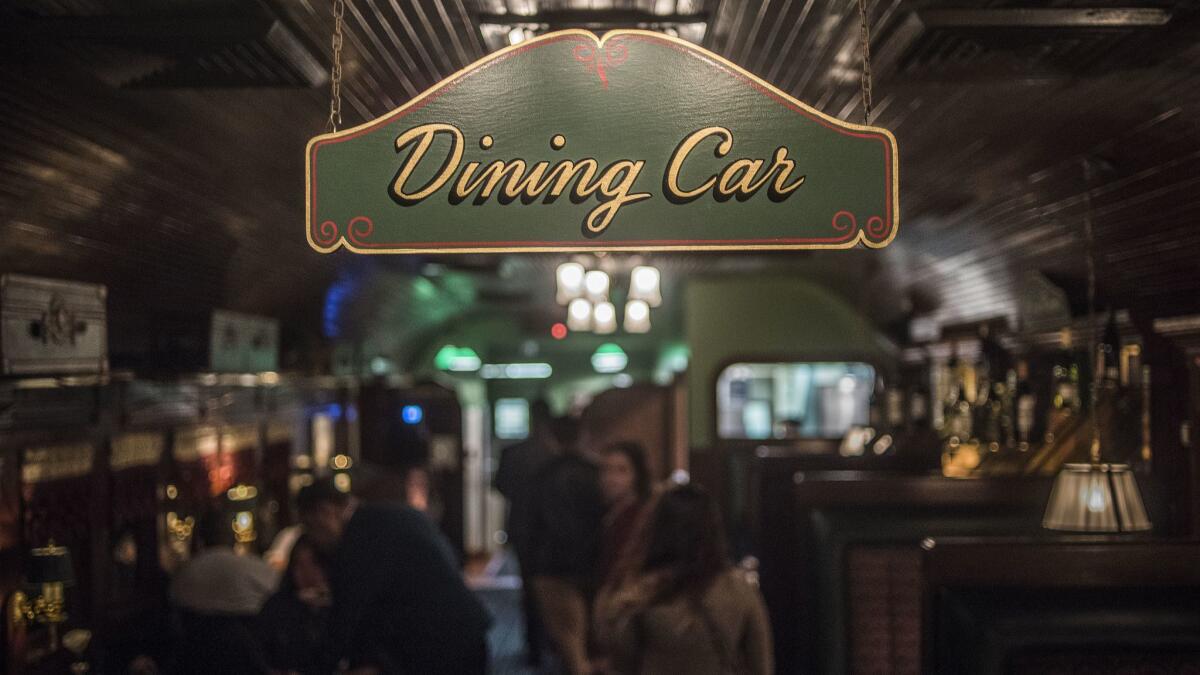Column: So long, and thanks for all the steak

In 1921, when the world had just barely recovered from a pandemic, Fred Cook and his wife, Lovey, opened a restaurant inside a replica dining car on the outskirts of downtown Los Angeles.
Nearly 100 years later, a different pandemic has claimed it. Pacific Dining Car in Westlake, one of the oldest restaurants in the city, has closed, and we are the poorer for it. (The Santa Monica location, opened in 1990, shut in June.) Pots and pans, wall sconces, valet uniforms and even the massive front signage — two plump bovines looking out placidly over the intersection of Witmer and West 6th streets — are all being sold at auction. As I write this, the bidding on the sign has closed at $7,250.
But however high that figure is, it won’t save the restaurant. Nor will it save us from the rapidly growing list of closures of our beloved dining institutions. And while this isn’t the first business to close due to COVID-19 and will not be the last, this one feels a bit different. It cuts a little deeper.
The unabashed homer in me says L.A. is the best city in the country to grab a meal, but I’ll admit there are blind spots — one being that bars and restaurants tend to close early. And Pacific Dining Car was a late-night escape in a city that, well, sometimes sleeps.
A 24-hour restaurant is a blessing no matter where you are, but especially here, and Pacific Dining Car took it up a notch. It was a 24-hour fine-dining restaurant, replete with crushed-velvet-upholstered, high-backed chairs, waitstaff in tuxes and tiny nets covering the lemon halves. It was your favorite diner but fancy. It certainly had no match in this city and, I imagine, this hemisphere.
It was an expensive place to eat — for special occasions, certainly — but there was a 10 p.m.-till-6 a.m. menu with cheaper options, and everyone knew you could nab a Groupon to make the final bill more palatable. Despite the cost, L.A.’s dearth of middle-of-the-night eating options meant that Pacific Dining Car ended up attracting every kind of person you could imagine — couples in prom clothes, nurses in scrubs, slick producer types, foreign tourists and their children, and club kids who decided, for whatever reason, that they wanted to cap a night out with a bone-in rib-eye, creamed spinach and Roquefort mashed potatoes.
You could waltz in wearing ripped jeans and a ball cap and sit next to a couple dressed for the Vanity Fair Oscar party and no one would look at you sideways. In that sense, it was the most egalitarian of restaurants.
One of the first times I went to Pacific Dining Car was with an old girlfriend, a native Angelena who reinforced in me an essential truth about L.A. dining: It’s the best city in the county for restaurants that are a little off-kilter or quirky in some way — Clifton’s, Cafe Jack, Dan Tana’s, Inn of the Seventh Ray. The vastness of the city, oft maligned, also supports idiosyncrasies: There’s room for everybody.
Inside Pacific Dining Car was all forest greens and polished brass; burnished wood and tasseled window dressings, even stowage above some of the tables to mimic the true train compartment experience. The size of the restaurant always surprised me — there were so many different dining rooms and hidden spaces, it was a pleasure to explore. On the walls you might see framed wine labels, miscellaneous Western-themed artwork, a mirror adorned with antlers or my favorite, above a table near the entrance to the “Club Car” room, a painting of a dog dressed as Napoleon.
The steaks were pretty good to very good. The sides were satisfactory. The wedge was swimming in blue cheese and candied bacon, as a good wedge should be. I’d sometimes get crab cakes or an omelette or something, just to be that guy at the steakhouse, and I wouldn’t be disappointed.
Because it was never really about the food: You weren’t going to go home and rhapsodize about the baseball steak or wax poetic over the eggs Benedict. It was about the shared experience with other diners — the knowledge that at exactly noon, or 3 p.m. or 2:44 a.m. or whatever time it was, you all independently made the conscious decision to hop into a car and head to an odd, wonderful little restaurant that looks like a train compartment, halfway between MacArthur Park and Pershing Square.
I don’t believe businesses are people (Sorry, Mr. Romney). But lives and livelihoods are inextricably intertwined, as the etymology would hint at. And if you subscribe to the notion that our residents and institutions are what make our cities great, it’s hard not to see this as a blow to Los Angeles. This was one of our oldest establishments — one that had seen two Summer Olympics come and go as well as 17 presidents and a handful of wars. Losing it is losing a small but essential part of Los Angeles.
I’m going to miss it.
More to Read
Eat your way across L.A.
Get our weekly Tasting Notes newsletter for reviews, news and more.
You may occasionally receive promotional content from the Los Angeles Times.







